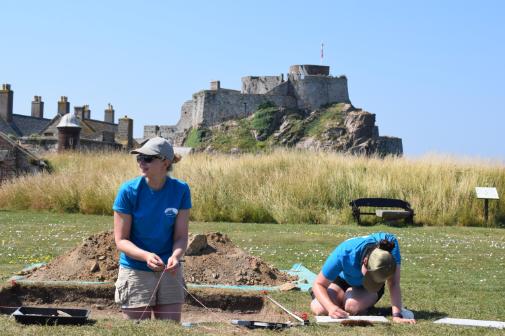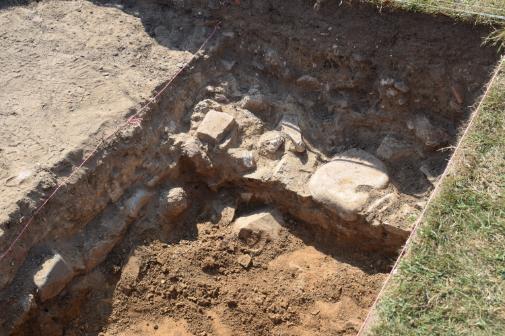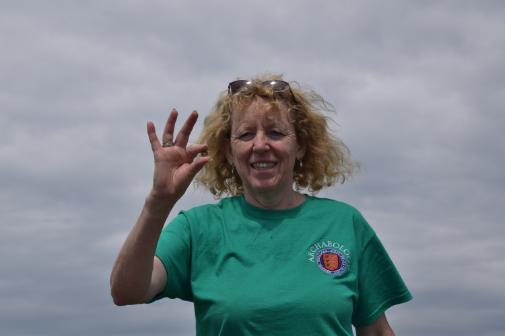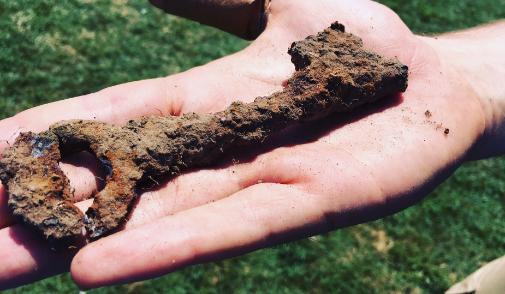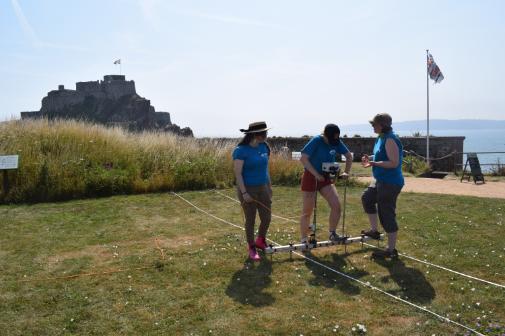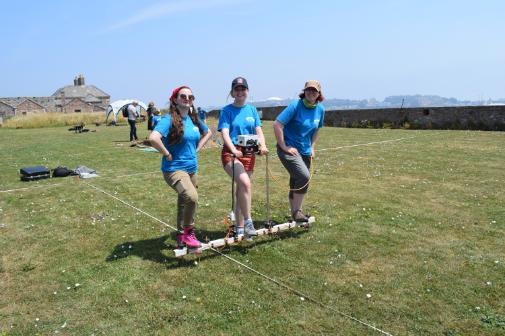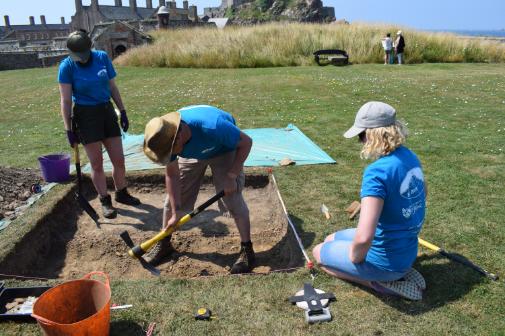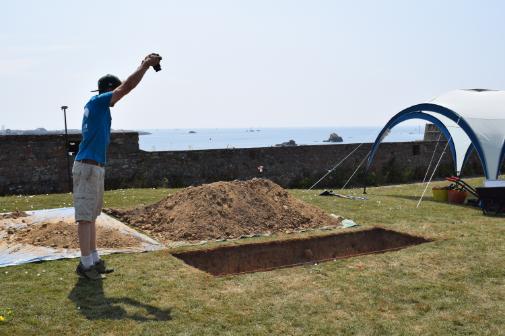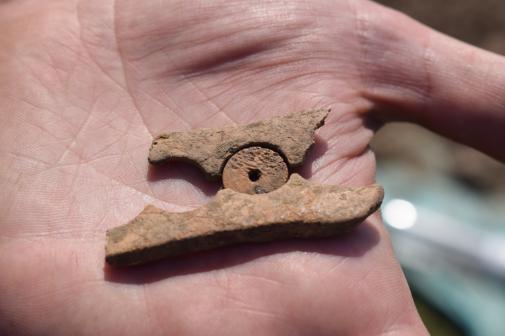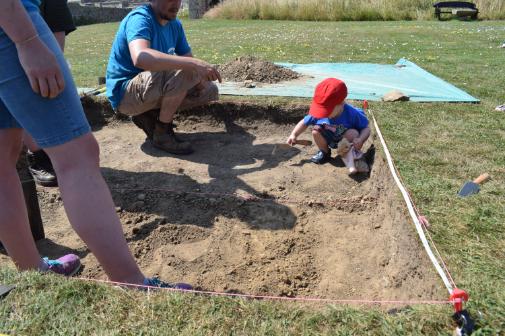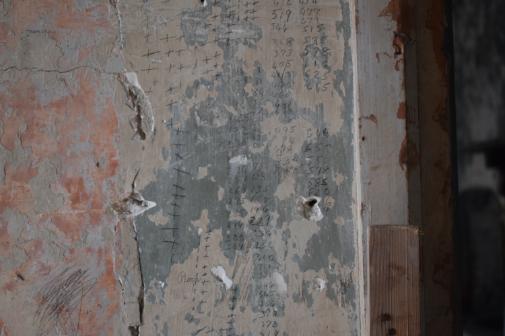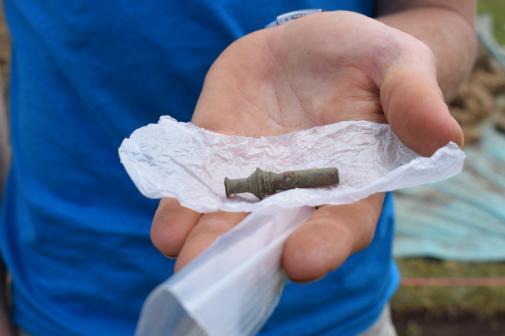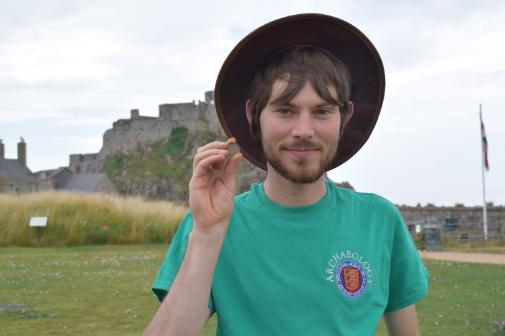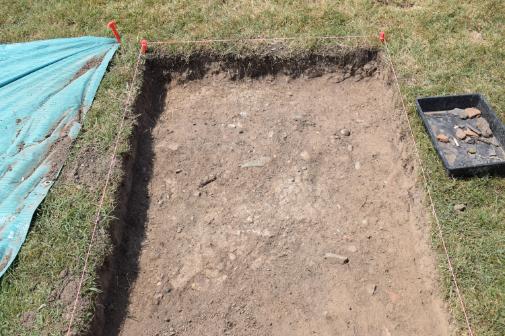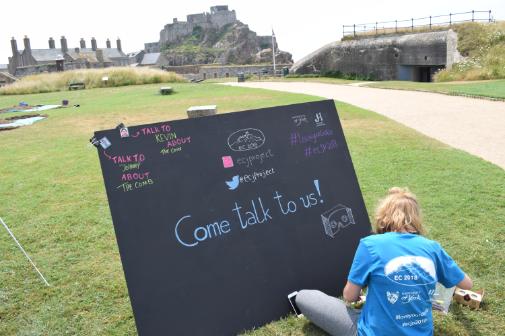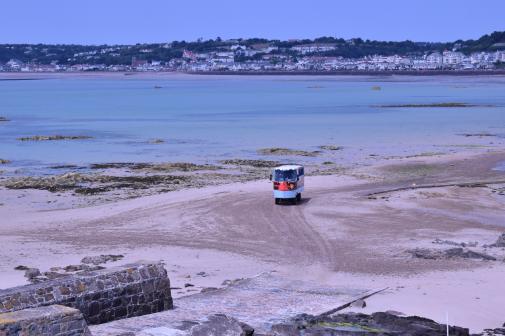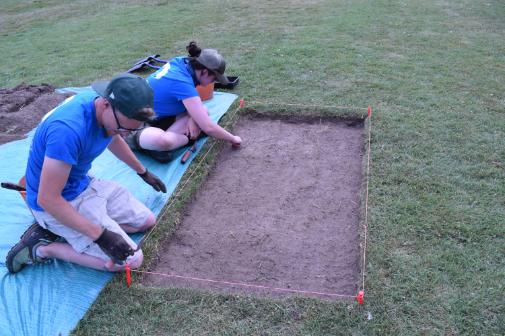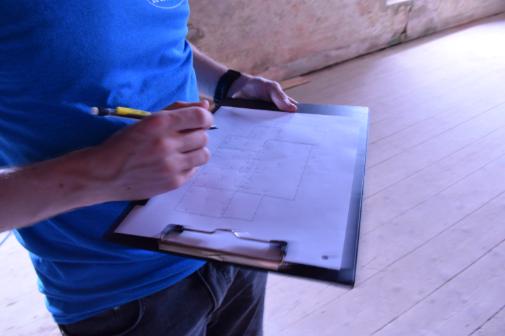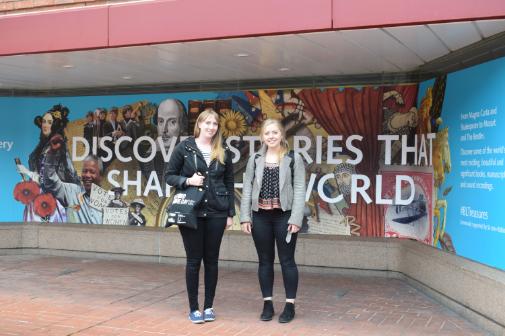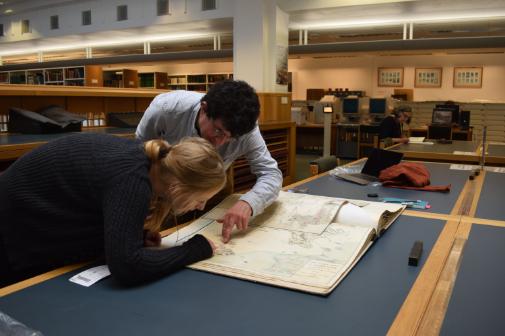Elizabeth Castle project, Jersey
Overview
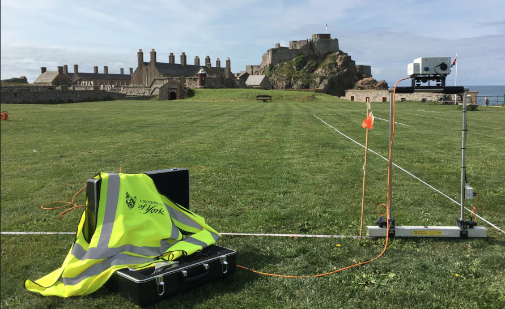
Since 2017 the Department of Archaeology and Jersey Heritage have been developing an exciting collaborative project at Elizabeth Castle, Jersey. Located on a tidal island in the bay overlooking the island's capital, St Helier, Elizabeth Castle has a rich and complex history encompassing the English Civil War, the 1781 Battle of Jersey, and German occupation during WW2.
ECJP2019
In the summer of 2019, the project will be focusing on documenting the surviving WWII evidence at Elizabeth Castle, including its casemates, personnel bunkers, and gun emplacements. The project will combine archaeological buildings recording, archival research, and conservation to record these structures, considering what stories they can tell, and how we might look after conserve and interpret them. The project will also continue its excavation on the Green, seeking to answer a number of questions raised by 2018 dig at the site of the lost Long Barracks.
The 2019 project will involve 5 staff and 16 students from the Archaeology Department at the University of York. We hope to work with a range of stakeholders, including the general project, to explore this brief but interesting period in Elizabeth Castle's long and rich history.
ECJP2018
The 2018 fieldwork project focused on the early C19th Hospital Block, a rare and fascinating example of its type. The adjacent Green was once the site of the C18th long barracks, long since demolished, but clearly visible through geophysical investigation. Activities for the project included archival research (in England and Jersey), building recording, geophysical investigation, excavation, digital heritage, and public engagement. The 8-day fieldwork programme culimated in a weekend of public archaeology at the site.
5 Staff and 14 students from the Department of Archaeology worked on site throughout the project, seeking to address 3 aims:
(1) To record, document, and analyse the development and use of the Hospital Block, in order to inform future management of this currently under-utilised structure;
(2) To undertake small-scale trench excavations to record and analyse the remains of the lost 18th-century barracks block on The Green;
(3) To engage the public in the story of Elizabeth Castle's Outer Bailey
Project Leads: Drs Dav Smith and Matt Jenkins
 c.1810 Hospital Block at Elizabeth Castle
c.1810 Hospital Block at Elizabeth Castle
Blog
Sunday 8th July 2018
Day 7 on Site
By the team from Trench 1
Kim, Zoe and Kevin were assigned Trench 1 at the beginning of the week and have written today's blog to let you know what they've been up to.
Trench 1, along with Trench 2 and the unopened Trench 5, was positioned to investigate part of the barracks. The geophysical survey had identified an intersection of rooms in this section of the lawn and we hoped that by targeting our excavation here we could shed new light on the internal makeup of the walls and their relationship to the rest of the building.
The excavation has been interesting as we have had to excavate a lot deeper than originally expected to encounter any walls, but by Day 5 we think we had located them. There have been clues about the presence of the building all week with our trench uncovering significant quantities of building material.
We have unearthed a number of interesting artefacts, such as a 1941 three pence piece, a board of ordnance military button (matching the buttons worn by the living history demonstrator), and a bone disc with a hole through the centre.
It has been great working at the site, particularly when we've been joined by volunteers from the Société Jersiaise, Jane and Jayne were a great source of local knowledge and uncovered some of the trenches most exciting finds!
Saturday 7th July 2018
Day 6 on Site
By the team from Trench 2
Johnny, Olivia and Matt have been working hard in Trench 2 all week and have written up a little summary of how work has progressed and some of the exciting things they have found.
Our trench was cited to try and intersect the corridor between the sets of rooms at the east end of the barracks complex. The geophysical survey from last year showed two potential walls divided by an empty gap in between which we used as a guide in locating the trench. Unfortunately we didn't find evidence for this, instead, in the first couple of days we discovered a possible floor surface and a handful of finds (mainly clay pipes, tiles and a partial comb).
By day 3 it started to get exciting! We uncovered what we thought to be a wall, and thought more structural evidence was starting to emerge. As work continued it became apparent that it was not a wall. However on towards close of play on Friday, a cobblestone floor surface started to emerge. It was the first solid piece of architecture evidence found on site. Here's Matt telling us a bit more about our changing interpretation.
While throughout the week we have uncovered exciting clues about the barracks and the people who lived there, Thursday was perhaps the most exciting. We opened a trench extension, laid out to hopefully find the intersecting point between our wall and a feature that had been revealed as a result of the dry weather through a scorch mark appearingin the lawn. Some other features can be seen in emerging in the grass in this image from a drone kindly provided for us by ITV.
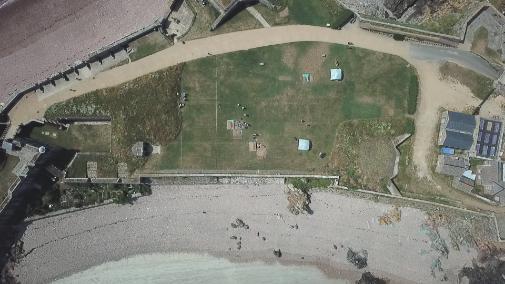
During the removal of topsoil the “find of the dig” popped out onto the trench floor, a key! Who knows what that key might unlock, but we didn’t have much time to consider as work continued
Friday 6th July 2018
Day 5 on Site
By the Geophysics Team
For today’s blog post we have asked the geophysics team to write a piece about their work. Here is what they had to say.
This week, we (Dr Helen Goodchild, Jess Prouse and Josie Teed) have been using Electrical Resistance (sometimes referred to as resistivity) to investigate Elizabeth Castle’s green. This is a relatively simple geophysical technique, which involves running currents through the ground, by inserting large probes into the soil so we can detect the resistance to the electrical currents. As electricity runs more easily through soft and wet materials; hard and dry elements, like walls or concrete, will likely stand out as they will be highly resistant to the currents. This is an important part of archaeological investigation as it allows us to detect changes below ground level without excavating an entire area, and also can indicate the best places for field archaeologists to excavate.
It is important to have an accurate grid to line up each ‘point’ of we take. On our first day, we spent the afternoon laying out the grid to ensure all our points were parallel. Although the ground seemed flat, this proved to be no easy feat! Small bumps, vegetation and other archaeological work frequently interfered, and we needed to take extra care to ensure that these elements did not alter our measurements.
It’s a hot summer here on Jersey, and the heat and dryness in the air made it hard for us to take accurate readings. This meant we had to use all of our strength to ensure the probes went far enough into the ground to pierce deeper soil. Even when we have been able to take measurements, we will have to wait until we download and interpret the data to see if the lackc of moisture has interfered with our work.
As we’ve seen here at Elizabeth Castle, geophysical investigations can present many challenges, but is a crucial and exciting part of the archaeological process.
Many thanks to the Geophysical team for their time to write this piece and for the work they have been doing for the past few days and their continuing work. We shall continue to keep you updated with our progress on our social medias and bringing you blogs from our other teams throughout the weekend.
You can remind yourself of what the geophysics team have already done by checking out Hen's introduction!
Thursday 5th July 2018
Day 4 on Site
By Paula Burbicka
The day started with a cloudless blue sky, and high expectations. After a short ride on the ferry and a comprehensive briefing on site, all of our lovely teams went off to work.
The excavating archaeologists started the day cataloguing the finds. Then the digging started again, with the team full of excitement, especially after a day full of amazing finds as was yesterday. The work started by extending Trench 2, with the aim of uncovering more structural evidence of the barracks. We hope to find more of what we are considering to be an internal wall. But before, the site had to be recorded. And so Matt set out to do a photogrammetry of the trench before extension.
Not soon after the top soil was off, a unique find emerged. It was a rusted metal key, almost immediately considered the find of the day. As it was found in the top the soil we can't yet directly associate it with the barracks. Nevertheless, the find remains of great value.

In the meantime, another major find was discovered in Trench I, a piece of worked bone which fitted into a bone token found only yesterday. Although the function is unclear, the interpretation tends towards a bead.
And if that was not enough, we also had a very enthusiastic little visitor that helped the team with the excavation. And he also found some more building materials associated with the complex!
Back in the hospital, the progress is steady. Today the team started a comprehensive survey of the ground floor and are continuing to work on a 3D visualisation of the first floor. They are aiming to have this bit ready for the open days on the weekend for the people to have a sneak peak into the inaccessible area of the complex. Moreover, some concrete ideas about some of the more ephemeral features on the lower level, numbers on a wall have been interpreted as dart scores associated with the visible remnants of the board just to the left of it.
The geophysics team was reunited yesterday with the arrival of Josie and Jess and they started to set up the site.

Wednesday 4th July 2018
Day 3 on Site
By Hannah Thompson
After another drizzly start the team were back to work on the island for day three of the project, with more exciting finds coming out of the trenches, including a fantastic 'mystery object', which the archaeologists were soon puzzling over. The current interpretation is that it is likely to be part of an oil burner although the verdict is still out on that one!
We also had some lovely volunteers on site with us, with three visitors from Jersey's own Société Jersaise helping out our team with the fieldwork. After being on site barely an hour, one of the volunteer team, Edward, had uncovered another coin, this time a shilling from 1947, proving that we have definite evidence of human occupation on the site. We also had an exciting find in the form of a broken clay pipe. Once used for tobacco smoking, sections of clay pipe are a fairly common find at these types of sites. However, this find is rather unusual; despite being an everyday item in the 18th century, it is rare to find two matching halves of the same pipe stem due to smoking practices at the time, with each person using the pipe breaking a section off the stem after use.
Further evidence of multi-phase human occupation of the site came in the form of post-medieval pottery shards found on site, including a green-glazed fragment and a pottery handle, discussed below by one of field team, Kim.
We also had a fantastic find in trench one, uncovered by one of our Societe Jersaise volunteers Jane. After Kim's button find, we were stunned to discover a second button, completely intact, with visible markings which indicate that it is likely linked to the Board of Ordinance, a theory strengthened by the presence of an almost identical button on the uniform of one of Elizabeth Castle's reanactors!
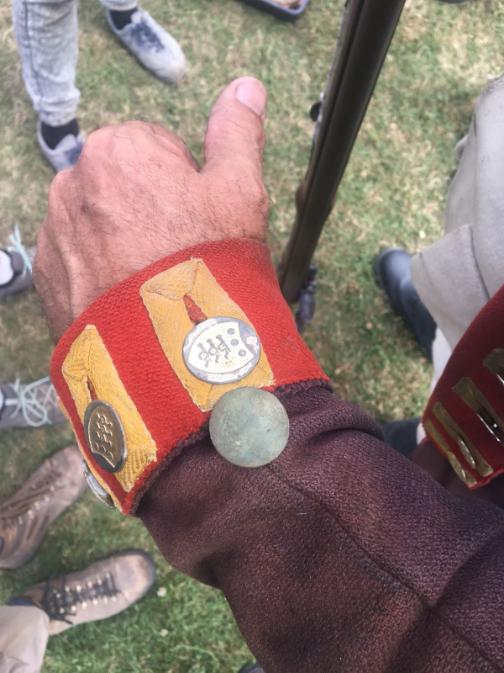
Elsewhere, unaware of changing weather conditions, our buildings survey team have been busy working away in the hospital building, with the 3D models of the block now beginning to take shape. Below is a sneak preview of the first-floor model produced by one of our fabulous team, Beth.

We were also pleased to welcome the rest of our team onsite today, with our Geophysical Survey team and archivists arriving in Jersey ready to begin work at Elizabeth Castle.
Excitingly, we are also now starting to get lots of interest from visitors to the castle, which is brilliant, with the project proving to be very stimulating for all involved, increasing our excitement for the open weekend ahead. With thanks to Jersey Heritage, our handling collection for the weekend has now arrived, where items similar to ours which were found previously on site will be available for visitors to interact with, including coins, clay pipes and even cannon balls! We are hoping that it will be an inspiring and lively couple of days, with lots to see and do on site.
Tuesday 3rd July 2018
Day 2 on Site
By Karl Henderson
After a dreary start, the team finished off removing the topsoil and began to trowel. Today has been a busy day for everyone on the team, as it’s the first day of full excavation. With hopes running high the day got off to a flying start with multiple finds being uncovered around couple of hours into the day! Two are worth a separate mention - a coin, dating from 1941 and a Bone comb perhaps from around 18th century. Besides, lots of building materials, a roof tiles and some pieces of pottery were also found as the they went on.
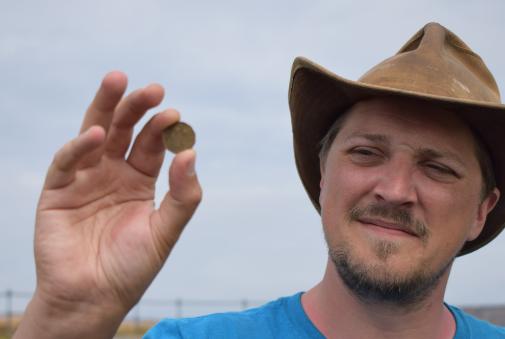
There were also so major surprises. One of the anomalies identified in last summers geophysical survey turned out to be a modern electrical cable running underground. Thus, a half of the trench had to be backfilled and expanded on the other side. Fortunately no more services were found after that! Another trench has uncovered a layer of cement, which could either date to the German occupation of the castle or could be modern. More research is needed to fully understand what is going on here.
Meanwhile, the building team have been working hard, using lots of pictures collated with photogrammetry to map the inside of the 19th century hospital buildings. The ultimate aim is the creation of a 3D model of the interiors. Here’s an interview with Richard, who told us more about what the building team were up to today.
The public engagement team has also set up a pop-up information centre and have been engaging with members of the public throughout the day, showing people around the site and answering any questions they may have.
It’s been a busy but equally a very rewarding day for all of us. Hopefully as the day ends, we’ll be able to find out more about the barracks and the detected anomalies, as well as uncover even more fascinating finds. Regardless of what happens, we’ll keep you up to date with all the latest updates both on here and on our Instagram ecjprojectI and on Twitter @ecjproject
Keep an eye out for those!
Monday 2nd July 2018
Day 1 on Site
By The Digital Heritage Team
Today was the first day of Elizabeth Jersey Castle Project 2018. After a short morning ride on the Charming Betty, we were finally on site!
Figure 1: The Charming Betty on route to the castle
We started off with a short introduction to the project and the site, followed by a fascinating tour that gave us a LOT to think about. We learned of the complexity of the island; the architectural features range anywhere between the 16th and 20th century. We also learned about the heritage and archaeological value of the site, including the picturesque castle crowning the whole compound. We instantly loved the fascinating visual complexity enriched by nature anywhere you walk. Then off we went to work, each team on a different aspect of the project.
One of the main foci of the projects is the site the 17th and 18th century barracks, the existence of which is well documented on old maps and documents. Unevenly-growing vegetation coupled with last year’s geophysics have revealed an approximate footprint of the structures buried underneath what is now the open terrain, covered by turf. The impact on this year’s project was immense.
A priority before the start of the excavation was to get an aerial overview of the site. After a successful and immensely exciting drone survey, our team of excavators started lay some trenches in the places of potential archaeology. Soon enough, the work was in full swing, and spades and trowels were digging away!
At the end of the day, fragments of clay pipes, pots and bones had emerged from the ground in some trenches. We are excited to see what else will be found in the upcoming days.
In the meantime, two of our surveyors started recording the 19th century hospital buildings on site. The buildings have a fascinating and complicated history. Amongst the decades of dereliction, original features, complemented by lots of subsequent ethereal evidence left by the German occupants and tourists alike are everywhere to see. Yet, recording them may be a challenge…. we will need to wait and find out!
Friday 29th June 2018
Visiting the Archives
By Emiy Pearson
Our first official day on the project began in May on the platform of York station at 6:30am. Although fuelled with excitement to finally get our teeth into the project and carry out, for myself, the first piece of research, coffee was still needed, in heavy supply, to get the wheels moving. This early start was a far cry from the usual moans of making it in for a 9am lecture! A number of the documents needed for this project are located in London, as well as important documents on Jersey itself. This meant two visits to London to visit both the National Archives at Kew and the British Library Archives.
Figure one: Rachel and Emily at the British Library
On most archaeological projects and excavations, the role of archival research is quintessential in gaining the most in-depth and accurate interpretations of sites. Often data retrieved from archival sources such as cartographic depictions, and letters, can reveal aspects previously unknown such as the position of buildings and primary accounts of life at the time. This is something which has proven key in unravelling the history of the Elizabeth Castle in Jersey. With the two sites of interest at the castle being the barracks and the hospital, the hunt for documents containing any trace or mention of these was analysed. The documentary evidence mostly consisted of maps with the occasional letter and muster book. There was also a difference in the types of information we found, as the hospital block is still standing but the barracks are not.
Arriving in London was thoroughly exciting to witness the hustle and bustle of rush hour as we made our way across on both the tube and overground train to Kew for our first visit. We sat enthralled by the thoughts of what could be uncovered at the archives, preempting what each document ordered could hold. Once at Kew we were not disappointed by the quantity and quality of documents. Possibly the most memorable was a detailed map from 1737 of Elizabeth Castle and the surrounding island. Much to my shock when it was handed to us, it took two people to carry! The measly one table we had taken over would not be enough to view even one corner. We commandeered a further 5 tables to in order to roll the map out fully, a task which took three people: two to roll and one to place weights at various points. This was for myself a first look at the site and where the buildings were, in relation to the size and scale of the island. From this we could begin to apply historic map regression in order to build a framework of dates as to when buildings were initially built and what changes might have been made when. We also began to think in terms of social contexts of the time, such as the development of an infectious room and greater awareness of disease and infection. There were also elements which challenged us, such as finding contradictions in possible dates for the establishment of the hospital, something which will be central in the work undertaken by the buildings historians when we begin work on the island in July.
Further documents included a regimental muster book detailing the names of men stationed on the island and their rank. Interestingly there were also some names of men who were listed as being under treatment at the hospital. From this evidence, the durations of stays within the hospital can be deduced. Seeing the names of these men brought an element of reality to the project as they would have used and occupied the spaces we are investigating. This is an element which will be pursued also by the heritage and visitor attraction team as a means of highlighting human interest.
The second trip to London at the British Library began at the much more agreeable time of 7:30, practically a lie-in in comparison! From this visit we were able to analyse further maps, this time gaining insight into the barracks with questions raised such as; structure, quantity and positioning of windows and size. As well as maps, there were also artist illustrations which interestingly contradicted the maps and drawings found at the archives in Kew. This is an aspect which will be further investigated by the excavation team.
Figure two: Pouring over map
With many exciting discoveries already made it will be interesting to see how these theories develop alongside the excavations, surveys and further archival research. I am looking forward to delving into this project further and hopefully seeing some incredible results!
Participants
Project Directors
Dr Dav Smith and Dr Matt Jenkins
Project Coordinator: Dr Catriona Cooper
Excavation Lead: Dr James Taylor
Geophysics Lead: Dr Helen Goodchild
Building Survey Lead: Dr Dav Smith
Archival Research Lead: Dr Matt Jenkins
Digital Heritage/ Public Engagement Lead: Dr Catriona Cooper
Excavation Team
- Kevin Claxton
- Olivia Srawley
- Jonny Farley
- Zoe Tomlinson
- Kimberley Withers
- Matt Amy
Geophysics Team
- Josie Teed
- Jess Prowse
Building Survey Team
- Bethany Watrous
- Richard Pougher
Archival Research Team
- Emily Pearson
- Rachel Edwards
Digital Heritage/ Public Engagement Team
- Karl Henderson
- Paula Burbica
- Hannah Thompson
Media
2 April 2018
https://jerseyeveningpost.com/news/2018/04/02/restoration-of-elizabeth-castle-hospital-to-begin/#Ot4JY74sRGPkq2ii.03
Code of Conduct
University of York
Elizabeth Castle 2018 Project
Code of Conduct Agreement
Elizabeth Castle 2018 is a new research project by the Archaeology Department, University of York, for Jersey Heritage. As well as a training exercise, this project contains a strong focus on public engagement and interaction. In order to ensure all participants (staff, student, & volunteers) understand their rights and responsibilities in maintaining a safe and friendly environment for all, we ask both as individuals and as a team that we reflect upon and agree to adhere to the following expectations.
As a members of a team:
(1) We are committed to working as a team. All aspects of our professional contributions to the project are discussed and agreed upon together, and all tasks – although they might be led by individual team members – are developed through collaborative practice. Supporting the team, working as a team player, providing constructive critique to your team members, and respecting the interests of the team as a successful working group (without compromising their safety or security, as described below), are paramount.
(2) We are committed to prioritising and championing the sites, people and communities that host us. We are privileged to be allowed to work on a site of special significance to its caretakers (Jersey Heritage), their staff, and the local community on Jersey. Our work is driven by local needs, and decision-making is grounded in evidence and robust data gathered in local contexts. We are critically aware of the existing evidence, and of local knowledge and expertise. We respect, care for, and seek to create long-lasting friendships and working relationships with our hosts.
(3) We have the right to a safe, secure and non-threatening working and living environment. We do not tolerate any form of discriminatory, abusive, aggressive, harassing, threatening, sexually or physically intimidating, or related problematic behaviours that compromise the wellbeing, equality, security or dignity of other people (whether they are our peers, colleagues, supervisors, collaborators, local community members, or any other persons at all). Considering this zero-tolerance policy, you agree to the following:
-
If I feel unsafe or uncomfortable, or I witness others being subjected to the same, I will report it immediately to my direct supervisor. If I feel I cannot speak to my direct supervisor, I will report it to one of the project directors. If I feel I cannot report it to either my direct supervisor or a project director, then I will contact the University of York Department of Archaeology.
-
I recognise that if I am implicated in behaviour that compromises the wellbeing, equality, security or dignity of other persons, I will be subject to disciplinary proceedings and may be required to leave the project at my own expense and may be subject to criminal investigation.
-
Our commitment to creating and maintaining safety and security for all extends to our online (web and social media) and mobile phone interactions, and we recognise that the process for reporting and acting on threatening online/mobile phone behaviours is the same as above.
-
If in a position of authority, I will be aware of my ethical and professional responsibilities (see links below), and will not actively or passively abuse that position.
As students and volunteers:
(4) We are committed to the working hours, professional expectations and responsibilities defined by the overall project directors. We typically work as part of a larger project team guided by wider goals than ours alone. We are aware of their responsibilities, we have read the necessary guidance documents, we have understood and signed the necessary insurance and risk assessment documentation, and in all cases, we respect and abide by the instructions given by the directors. This includes zero tolerance in relation to behaviour that compromises the wellbeing, equality, security, or dignity of other human beings, as described below.
(5) We are representatives and extensions of the University of York and its staff, which are world-renowned for archaeology and heritage research and training. Our behaviours reflect on this Institution and its representatives, and we recognise that our direct supervisor is bound by the ethical and professional codes of both York and other professional associations.
Considering these obligations, you agree with the following:
-
I will come to my direct supervisor the moment I experience problems, challenges or trouble of any kind. I will keep them informed of any issues I feel may manifest themselves in relation to myself, my teammates, or affiliates while in the field.
-
If I feel I need support beyond my direct supervisor, I will turn to a project director for their advice.
-
I have already disclosed to the Project Coordinator any potential matters of concern (which may include matters relating to health and psychological and physical wellbeing, security, equality, confidence, interpersonal relations, previous travel or fieldwork experiences, etc.) so that they are aware of them and can mitigate/ameliorate them prior to departing for – and during – fieldwork.
-
If I have not yet disclosed such matters, I agree to do so as soon as possible. I have shared this information in confidence, with an expectation of complete privacy unless urgent medical (or related) intervention is required.
-
I will wear a Project T-shirt whenever on site. I will be mindful that whenever wearing that t-shirt (both on and off site) I will be a visible representative of both the Project and the University of York, and behave accordingly.
As team leaders, supervisors and project directors:
(6) We recognise you are here in a capacity to learn new skills and gain experience. We commit to helping you develop new skills in the field alongside meeting the needs of the project.
(7) We recognise that fieldwork can be intense, emotional and tiring. We understand that things can go wrong, that we may need to compromise, and that in exceptional circumstances, we made need to shorten or modify your work on site to help manage these circumstances. In such cases, we will have a series of conversations which you or we may initiate about how to deal with difficulties, led by your direct supervisor and/or a project director.
(8) We will provide you with a safe working environment. We will have completed the appropriate health and safety and risk assessments prior to the beginning of the project. The project methodology will have been developed, and will be followed, to ensure your safety. As part of our commitment as a team (point 3), we will endeavour to manage and resolve any reported issues on your behalf to ensure the provision of a safe, secure and non-threatening working and living environment for all participants.
Important University of York Links
Health and Safety:
https://www.york.ac.uk/archaeology/intranet/dept-info/health-and-safety/
Code of Ethics: https://www.york.ac.uk/staff/research/governance/research-policies/ethics-code/
Code of Practice On Harassment: https://www.york.ac.uk/admin/eo/Harassment/code.htm
Personal Relationships Policy: https://www.york.ac.uk/admin/hr/policies/hr-procedures/personal-relationships/policy/
Drug and Alcohol Policy: https://www.york.ac.uk/admin/hr/policies/health-well-being/alcohol-drug-substance/policy/
Open Weekend
We will be running an open weekend on 7 and 8 July 2018. Here you see the work we are doing, interact with the staff and enjoy some of the activities we will have available including:
- Make your own reconstruction of the site from Lego
- Archaeological Handling Collections
- Engage with the evidence from the Archives
There will also be tours led by our team of experts running throughout the day.
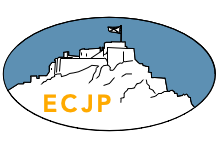
Department of Archaeology
University of York,
King's Manor,
York,
YO1 7EP,
UK
Tel:
work
+44 (0) 1904 323972
|
archaeology@york.ac.uk
Legal statements | Privacy | Cookies | Accessibility
© University of York | Modify | Direct Edit

